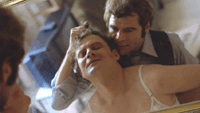In a Year of 13 Moons opens to a curious image of an enigmatic figure – made exaggeratedly imposing by the isolated shot of the lumbering, awkward gait of ill-fitting industrial boots – unassuredly cruising a near empty tree-lined Frankfurt plaza at daybreak before catching the attention of a male prostitute who indiscreetly follows the prospective client into an adjacent park clearing, initiates aggressive intimate contact and, upon discovering that his solicitor is, in fact, not a man but a woman dressed in masculine attire, summons his fellow co-workers to participate in her violent assault until she breaks free from the pack and runs away into the obscuring trees. The fragmented introductory sequence, alternately presented in distanced long shots and equally indistinguishable extreme close-ups, provides a remarkably incisive characterization of the victim, Elvira (Volker Spengler) who, having recently experienced a painful breakup with her live-in lover Christoph (Karl Scheydt), decided one day to don men’s clothing in a feeble attempt to outwardly conceal the embarrassing situation of a lonely woman procuring anonymous sex in the early hours of the morning. It is a scenario that proves all too familiar to Elvira – a desperate soul constantly metamorphosing into the guise of another in an interminable search for love – having earlier led a seemingly mundane existence as a man named Erwin Weishaupt trapped in a passionless, yet convenient marriage to a teacher, Irene (Elisabeth Trissenaar) and who, after an off-handed remark by the ambitious and seductive upstart, a Holocaust surviver from Bergen-Belsen named Anton Saitz (Gottfried John), impulsively decided to leave his job at the slaughterhouse and travel to Casablanca for a backroom transsexual operation in the illusory hopes of winning Saitz’s aloof affection. With Saitz now a wealthy and politically connected industrialist, Irene confronts Elvira on the publication of a potentially chagrining magazine interview in which a candid Elvira recounts the sordid details of her unrequited relationship with the successful entrepreneur and urges her to meet with Saitz in order to offer a personal apology for the sake of their daughter Marie-Ann (Eva Mattes). Publicly humiliated, abandoned by her lover, and estranged from family, Elvira is pushed to the breaking point when she is forced to seek out and confront the elusive object of her bittersweet desire and tormenting past.
Filmed in the aftermath of Fassbinder’s estranged lover, Armin Meier’s suicide (who is believed to have intentionally overdosed on sleeping pills on the filmmaker’s birthday, but whose body was not discovered until a week later), In a Year of 13 Moons is a distilled, brutal, unrelenting, deeply personal, and emotionally honest exposition into the human existential quest for love, acceptance, spiritual passion, and inclusion. The film’s recurring theme of impersonation and shedding of one’s skin – depicted literally through the indelibly (and infamously unsettling) graphic assembly line sequence of cows being systematically bludgeoned, exsanguinated, flayed, and butchered at a slaughterhouse as Elvira recites a passage from Johann Wolfgang von Goethe – is also illustrated in the protagonist’s paradoxical attempts at gender re-identification, both as a woman (for Saitz and subsequently, Christoph) and as a man (for his family), in Elvira’s ill-fated solicitation of a hustler, in Saintz’s grotesque mimicry of Jerry Lewis’ spasmodic performance in the Martin and Lewis film, You’re Never Too Young, and is also alluded in Elvira’s childhood when young Erwin, cast off by his biological mother into an orphanage with no prospects for adoption, seemingly sheds his obedient demeanor and becomes a troublesome delinquent. Fassbinder’s familiar imagery of framing characters through rectangular passageways (particularly vestibules and doorways) that underscore their isolation is further magnified in the idiosyncratically hermetic image of Elvira traversing the corridor of a near vacant office building in search of Saintz that reinforces her profound, inescapable isolation, even in a place where inhabitants similarly seek escape from their misery through acts of self-destruction and voyeurism. It is this image of the “outsider among outsiders” – a theme similarly explored in Fassbinder’s earlier film Fox and His Friends – that invariably underpins the desperate, inarticulable tragedy of the film: the systematic disembodiment of humanity and suppression of personal identity in the desolate reality of primal survival, pleasure seeking, material gain, and unthinking conformity.
© Acquarello 2004. All rights reserved.
